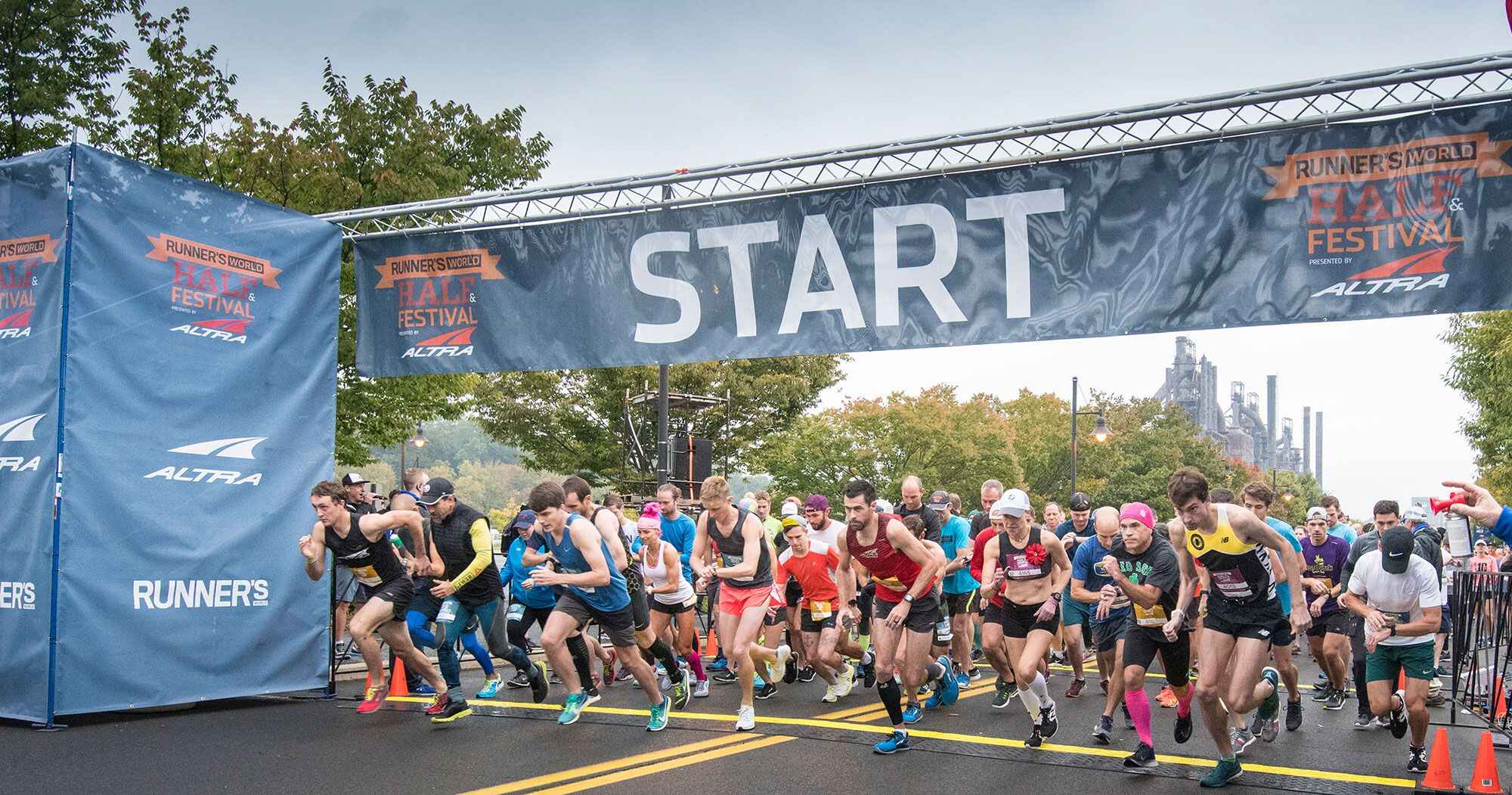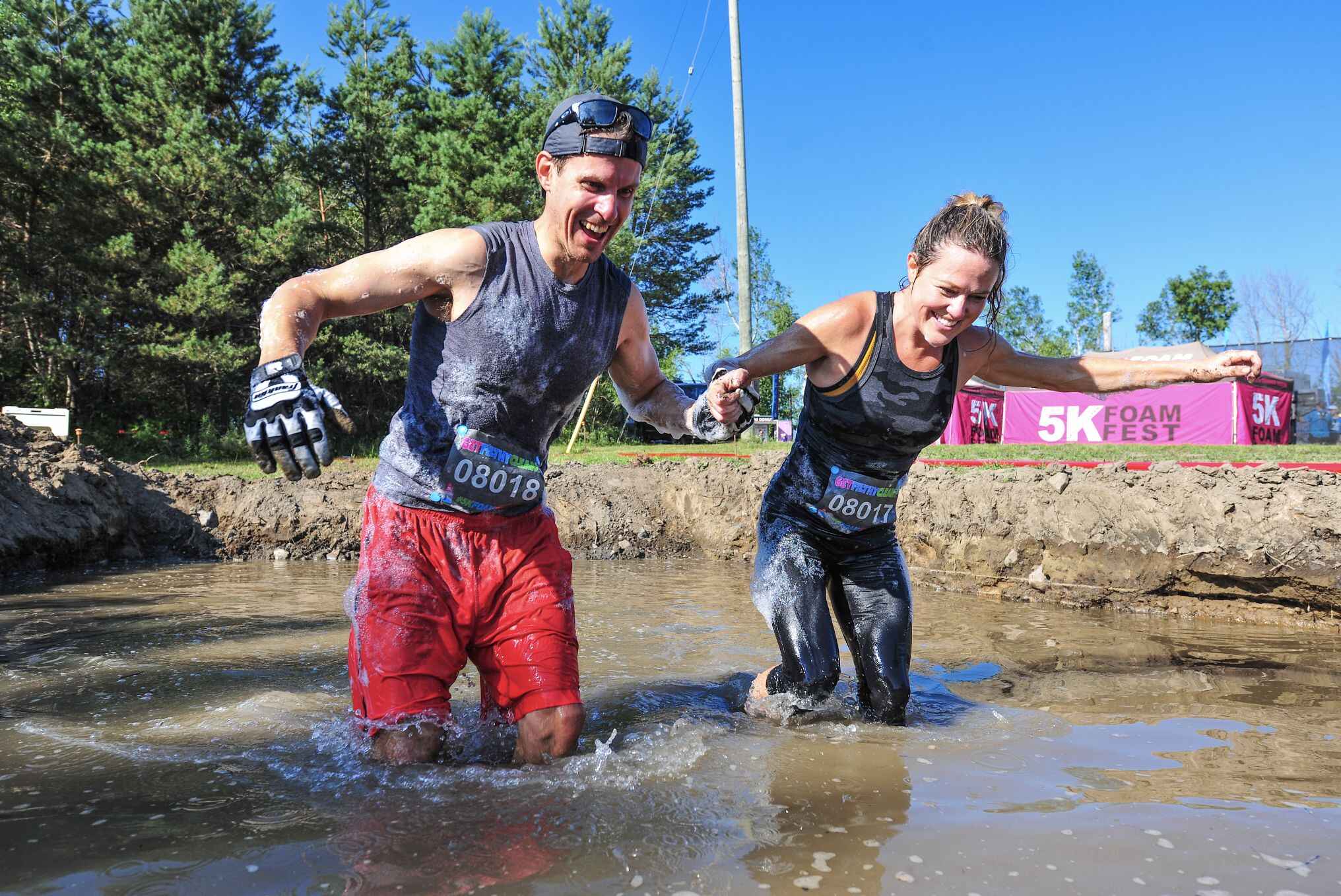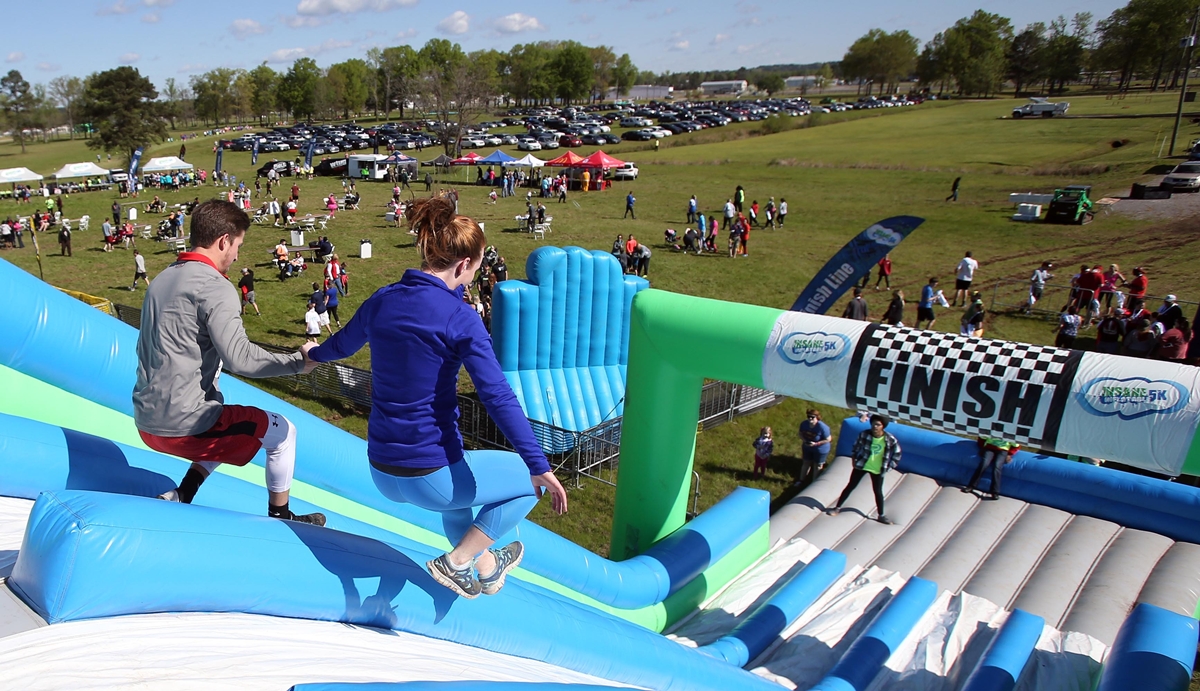

Featured
How To Prepare For A 5K Run
Modified: August 21, 2023
Get ready to dominate your next 5K run with our featured guide on how to prepare physically and mentally. Follow our expert tips and tricks to optimize your training and cross that finish line with confidence.
Introduction
Welcome to the world of running! Whether you’re a beginner or an experienced athlete, participating in a 5K run is an exhilarating experience that can push your physical and mental boundaries. The 5K, which is equivalent to 3.1 miles, is a popular distance for both competitive races and fun runs. It’s a fantastic goal for those looking to challenge themselves and improve their overall fitness level.
Preparing for a 5K run requires dedication, commitment, and proper training. This article will guide you through the essential steps to help you prepare effectively and ensure a successful race day. From setting goals to incorporating the right training techniques, we’ll cover everything you need to know to get started on your 5K journey.
Before diving into the training aspects, it’s important to note that running a 5K can have numerous benefits. It not only improves cardiovascular fitness, but it also boosts mental health, increases bone density, and even aids in weight loss. Additionally, participating in a 5K run can be a great way to contribute to a charitable cause or bond with friends and family.
Now that you’re motivated and ready to take on the challenge, let’s explore the essential steps to help you prepare for a 5K run. Whether you’re aiming for a personal best or simply looking to complete the distance, this guide will provide you with the knowledge and tools you need to succeed.
Setting a Goal
One of the most crucial steps in preparing for a 5K run is setting a realistic and achievable goal. Having a specific goal in mind will not only provide you with motivation but also give you a clear direction for your training. When setting your goal, consider your current fitness level, previous running experience, and the time you have available to train.
Start by determining your desired outcome for the race. Are you aiming to complete the 5K distance without stopping? Or do you have a specific time goal in mind? It’s important to be realistic with your expectations, especially if you’re new to running or haven’t been consistently active. Setting small, incremental goals can help you build confidence and progress steadily.
Once you’ve decided on your goal, write it down and place it in a visible location. This will serve as a constant reminder of what you’re working towards and keep you motivated throughout your training journey.
It’s also beneficial to break down your larger goal into smaller milestones. For example, if your ultimate goal is to complete the 5K in under 30 minutes, set smaller benchmarks along the way, such as running a mile without stopping or completing a 3K run in a specific time. Celebrating these smaller achievements will help you stay motivated and track your progress.
Remember that everyone’s goals will be different, and what works for one person may not work for another. Listen to your body and be flexible in adjusting your goals as needed. The key is to challenge yourself while also making sure your goals are attainable.
In addition to setting a time or distance goal, consider setting non-performance-based goals as well. These could include things like improving your running form, sticking to a consistent training schedule, or simply enjoying the process. By focusing not just on the outcome but also on the journey, you’ll find greater satisfaction and long-term success.
Setting a clear and achievable goal is the first step to success in preparing for a 5K run. Once you have your goal in place, you can move on to the next essential aspect of your training: creating a training schedule.
Creating a Training Schedule
Now that you have set your goal, it’s time to create a training schedule that will help you progressively build your fitness and endurance for the 5K run. A well-designed training plan will ensure that you are adequately prepared for the distance on race day.
Start by assessing your current fitness level and determining how many days per week you can dedicate to training. Ideally, aim for at least three to four days of running per week to allow for proper rest and recovery. If you are a beginner, it’s important to start slowly and gradually increase your training volume over time.
When creating your training schedule, include a mix of different types of runs. This will help you develop the necessary strength, endurance, and speed for the 5K distance. Here are a few key components to consider:
- Easy Runs: These runs should be at a comfortable pace that allows you to maintain a conversation while running. They help build your aerobic base and improve endurance.
- Long Runs: These runs are typically done once a week and gradually increase in distance over time. Long runs help build stamina and mental toughness.
- Interval Training: This involves alternating between periods of high-intensity running and recovery. It improves speed, cardiovascular fitness, and enhances your ability to sustain a faster pace.
- Tempo Runs: These runs are performed at a comfortably hard pace, just below your race pace. They help improve your lactate threshold and teach your body to sustain a faster pace for longer periods.
- Rest and Recovery: Make sure to incorporate rest days into your training schedule to allow your body to recover and prevent overtraining. Use these days for active recovery, such as stretching or low-impact cross-training activities.
As you progress through your training, gradually increase the duration and intensity of your runs. This will help your body adapt and improve your fitness level. However, it’s important to listen to your body and avoid overtraining or pushing yourself too hard. Rest days and recovery are just as crucial as the running itself.
Keep in mind that your training schedule should also consider any other commitments or events in your life. It’s essential to strike a balance between training and your personal or work life to avoid burnout.
Lastly, make sure to track your progress along the way. Keep a training journal or use a running app to record your mileage, pace, and how you feel during each run. This will not only help you stay accountable but also allow you to identify areas of improvement and adjust your training schedule as needed.
By creating a well-structured training schedule and sticking to it, you’ll be on track to building the necessary fitness and endurance to conquer the 5K distance.
Warm-up and Cool-down
Properly warming up before a run and cooling down afterwards are essential components of your training routine. They help prepare your body for the physical demands of running and aid in recovery, reducing the risk of injury.
Before each run, spend 5-10 minutes performing a dynamic warm-up. This can include exercises such as jogging in place, high knees, butt kicks, leg swings, and arm circles. The purpose of these exercises is to increase blood flow to the muscles, improve mobility, and activate the muscles you’ll be using during your run.
After your warm-up, it’s important to ease into your run with a few minutes of easy jogging. This gradual increase in intensity allows your body to adjust and prevents any sudden stress on your cardiovascular system.
Once you’ve completed your run, dedicate a few minutes to cooling down. This can include a slow jog or walk to bring your heart rate back down to normal. Performing static stretches for the major muscle groups you used during your run is also beneficial for improving flexibility and preventing muscle tightness.
Additionally, incorporating foam rolling or self-massage with a massage ball can help release any tension or knots in your muscles. This can aid in recovery and alleviate any post-run muscle soreness.
The warm-up and cool-down are not only important for injury prevention but also for improving your overall running performance. They allow your body to transition into and out of the high-intensity running smoothly. By consistently including these routines in your training, you’ll notice improved flexibility, reduced muscle soreness, and enhanced recovery.
Remember, the warm-up and cool-down are just as important as the actual running portion of your workouts. Make them a non-negotiable part of your training routine to stay injury-free and optimize your performance.
Choosing the Right Gear
When it comes to preparing for a 5K run, having the right gear can make a significant difference in your comfort, performance, and overall running experience. Here are some key considerations when choosing the right gear:
Running Shoes: Invest in a pair of running shoes that are specifically designed for your foot type and running style. Visit a specialty running store where experts can analyze your gait and recommend the best shoe for you. Properly fitting shoes that provide adequate support and cushioning will help prevent injuries and enhance your running efficiency.
Apparel: Choose moisture-wicking and breathable clothing that suits the weather conditions. Opt for lightweight and comfortable materials that allow for freedom of movement. Consider dressing in layers to accommodate temperature changes during your runs. Don’t forget to wear a supportive sports bra for women and comfortable socks that prevent blisters.
Accessories: Depending on your preferences and needs, consider investing in accessories such as a GPS watch to track your distance and pace, a running belt or armband to carry your phone and other essentials, and reflective gear or a headlamp if you’ll be running in low-light conditions. These accessories can enhance your running experience and safety.
Hydration: Carry a handheld water bottle or wear a hydration belt if you’ll be running for longer durations or in hot weather. Staying hydrated is crucial for maintaining performance and preventing dehydration. Additionally, consider using a sports drink or electrolyte supplements to replenish the minerals lost through sweat during your runs.
Weather Protection: Prepare for various weather conditions by having a lightweight rain jacket or windbreaker for rainy or windy days, a hat or visor to protect your face from the sun, and sunscreen to prevent sunburn. Being prepared for different weather scenarios will ensure your comfort and safety during your runs.
Experiment and Test: It’s important to experiment with different gear and find what works best for you. Try out different shoe models, clothing options, and accessories during your training runs to determine what feels most comfortable and supportive. Avoid using brand-new gear for race day to prevent any discomfort or unexpected issues.
Remember, the right gear will not only enhance your performance but also provide the necessary comfort and protection during your training and on race day. Take the time to research, invest in quality gear, and prioritize your running essentials to set yourself up for a successful and enjoyable 5K experience.
Hydration and Nutrition
Proper hydration and nutrition play a crucial role in your performance and overall well-being during training and on race day. Here are some guidelines to help you stay properly fueled and hydrated throughout your 5K journey:
Hydration: Hydrating before, during, and after your runs is essential for maintaining optimal performance and preventing dehydration. Start by ensuring you’re well-hydrated throughout the day by drinking water regularly. Before a run, aim to consume 8-16 ounces of water or a sports drink about an hour beforehand. During your runs, especially if they’re longer or in hot conditions, aim to drink fluids every 15-20 minutes. After your run, replenish your fluid levels by consuming water or a sports drink to replace any lost fluids.
Nutrition: Fueling your body with the right nutrients before and after your runs is vital for energy and recovery. Prior to your runs, opt for a balanced meal or snack that includes carbohydrates for energy, a moderate amount of protein for muscle repair, and a small amount of healthy fats for sustained energy. Good pre-run snack options include a banana with peanut butter, a granola bar, or a small bowl of oatmeal. After your runs, focus on eating a combination of carbohydrates and protein to aid in muscle recovery. This can be achieved by consuming a post-run smoothie with fruits and protein powder or a balanced meal with lean protein and complex carbohydrates.
Timing: Pay attention to the timing of your meals and snacks. It’s important to allow enough time for proper digestion before a run to avoid discomfort. Aim to eat a larger meal 2-3 hours before running or have a small snack 30-60 minutes prior. After your runs, try to consume your post-run meal or snack within 30-60 minutes to optimize recovery.
Listen to Your Body: Everyone’s hydration and nutritional needs may vary, so it’s essential to listen to your body’s signals. If you feel thirsty, drink water. If you notice your energy levels are low during your runs, experiment with consuming energy gels or chews for quick fuel. Pay attention to how different foods and fluids make you feel during your training and make adjustments as necessary.
Consult a Nutritionist: If you’re unsure about your specific hydration and nutrition needs or have specific dietary requirements, consider consulting a registered dietitian or nutritionist. They can provide personalized guidance and help you develop a fueling plan tailored to your individual needs and goals.
Remember, proper hydration and nutrition are keys to optimizing your performance and recovery during 5K training. Don’t underestimate the importance of fueling your body effectively to ensure a successful race day experience.
Building Endurance
Building endurance is a crucial component of preparing for a 5K run. Endurance is your body’s ability to sustain activity over an extended period of time, and improving it will help you maintain a steady pace throughout the race. Here are some strategies to help you build endurance:
Gradual Progression: Start by gradually increasing the distance and duration of your runs. Ideally, aim for a weekly mileage increase of no more than 10%. This allows your body to adapt to the demands of running and prevents overuse injuries. Patience is key – building endurance takes time, so be consistent and focus on steady progress.
Long Runs: Long runs are the cornerstone of endurance training. Once a week, dedicate a run to gradually increasing your distance beyond the 5K mark. Start with a distance that feels challenging but manageable, and gradually increase it over time. Long runs improve your cardiovascular fitness, mental toughness, and ability to sustain a steady pace for longer periods.
Consistency: Consistency is key in building endurance. Aim to run at least three to four times a week, making sure to include a mix of easy runs, long runs, and other training sessions. Avoid skipping runs or having long gaps between workouts, as this can hinder your progress. Even if you can’t commit to long runs every week, maintaining a consistent running routine will help you build endurance over time.
Interval Training: Interval training, which involves alternating between high-intensity bursts of running and recovery periods, can significantly improve your endurance. Incorporate interval sessions into your training plan once or twice a week. Start with short intervals, such as 30 seconds of sprinting followed by one minute of walking or jogging, and gradually increase the duration and intensity of the intervals as you progress.
Progressive Overload: Gradually increasing the demands on your body is essential for building endurance. Incorporate progressive overload into your training by slightly increasing your pace or distance each week. This progressive challenge forces your body to adapt and become stronger over time.
Pacing: Learning to pace yourself is crucial for endurance running. Practice running at a pace that is sustainable for longer distances. This involves starting out conservatively and gradually increasing your speed as you feel more comfortable. Avoid the temptation to go out too fast at the beginning of your race and risk burning out before the finish line.
Mental Conditioning: Endurance running requires mental strength and focus. Develop mental toughness by incorporating longer runs, visualization techniques, and positive affirmations into your training. Keep a positive mindset, especially when the going gets tough during your runs.
Building endurance for a 5K run is a process that takes time and consistent effort. Be patient with yourself and trust in the training process. As you gradually increase your mileage, conquer longer runs, and improve your overall fitness, you’ll find yourself becoming more and more capable of completing the 5K distance with ease.
Incorporating Interval Training
Interval training is a powerful tool for improving your running performance and increasing your overall speed and endurance. By incorporating high-intensity intervals into your training routine, you can push your limits, improve your cardiovascular fitness, and enhance your ability to sustain a faster pace. Here’s how you can effectively incorporate interval training into your 5K preparation:
Understanding Intervals: Interval training involves alternating between periods of high-intensity running and active recovery. The high-intensity intervals are performed at a challenging, near-maximum effort, while the recovery periods allow for active rest to help you recover and prepare for the next interval.
Start with the Basics: If you’re new to interval training, start with shorter intervals and longer recovery periods. For example, you can begin with 30-second sprints followed by 90 seconds of walking or easy jogging. As you progress and become more comfortable with these intervals, you can gradually increase the duration and intensity.
Progressive Overload: To continue challenging yourself and making progress, it’s important to incorporate progressive overload into your interval training. This means gradually increasing the duration or intensity of your intervals over time. For example, you can increase the duration of your sprints or reduce the recovery time between intervals.
Vary Your Intervals: There are different types of interval workouts you can incorporate into your training. For instance, you can do pyramid intervals where you gradually increase and then decrease the duration or intensity of your intervals. Alternatively, you can try ladder intervals where you progressively increase the duration or intensity of your intervals and then decrease them. Mixing up your interval workouts not only prevents boredom but also challenges your body in different ways, helping you continually improve.
Use Technology: Consider using a running watch or a smartphone app with interval timing features. These tools allow you to set specific intervals and track your performance during the workout. They can provide audio cues or visual alerts to help you stay on track with your intervals, making your training sessions more structured and effective.
Listen to Your Body: As with any training method, it’s important to listen to your body and adjust the intensity or duration of your intervals as needed. If you’re feeling fatigued or experiencing pain, it’s best to dial back the intensity or give yourself extra rest. Pushing yourself too hard can increase the risk of injuries and hinder your progress.
Combine Interval Training with Other Runs: Interval training should be integrated into your overall training plan. Combine it with easy runs, long runs, and other workouts to create a well-rounded training routine. This variety will help improve different aspects of your running, such as endurance, speed, and race pace.
Recover Properly: Interval training places a significant amount of stress on your body. Make sure to incorporate appropriate rest and recovery days into your training schedule. This will allow your body to repair and adapt, maximizing the benefits of your interval training sessions.
By incorporating interval training into your 5K preparation, you can significantly improve your speed, endurance, and overall race performance. Be consistent, gradually increase the intensity, and enjoy the benefits that interval training brings to your running journey.
Strength Training for Runners
When preparing for a 5K run, incorporating strength training into your routine offers numerous benefits. It helps improve your overall strength, muscular endurance, and running economy, which can translate into better performance and reduced risk of injury. Here’s how you can integrate strength training into your 5K preparation:
Focus on Functional Movements: Emphasize exercises that mimic the movements used in running. Squats, lunges, deadlifts, and step-ups are excellent compound exercises that target multiple muscle groups and help develop leg strength and stability.
Include Upper Body Work: While running primarily engages the lower body, having a strong upper body can assist in maintaining proper posture and balance. Incorporate exercises such as push-ups, pull-ups, and rows to strengthen your core, back, and arms.
Core Strength: A strong core is vital for running efficiency and stability. Incorporate exercises like planks, Russian twists, and mountain climbers to develop core strength and stability. This will improve your overall running form and help prevent injuries.
Balance and Stability: Include balance and stability exercises to improve proprioception and reduce the risk of ankle and knee injuries. Single-leg exercises like single-leg squats or lunges, and exercises utilizing balance boards or stability balls can help improve stability and joint control.
Plyometrics: Plyometric exercises, such as box jumps or jump squats, can help improve your power and explosiveness, allowing you to generate more force and speed while running. These exercises should be performed with proper form and gradually progressed to avoid overuse injuries.
Incorporate Resistance Training: Include resistance training using weights or resistance bands to increase overall strength. Gradually increase the resistance as you become more comfortable with the exercises. Aim for two to three strength training sessions per week, allowing for adequate recovery between sessions.
Proper Form and Technique: Ensure you maintain proper form and technique throughout your strength training exercises. This will not only maximize the benefits but also reduce the risk of injury. Consider working with a certified trainer or coach to learn the correct form for each exercise.
Rest and Recovery: Allow for proper rest and recovery between strength training sessions. Your muscles need time to repair and rebuild to become stronger. Adequate rest can help prevent overuse injuries and optimize the benefits of your training.
Progression: Gradually increase the intensity, resistance, and complexity of your strength training exercises. This progressive overload will continuously challenge your muscles and help you make gains in strength and performance.
Remember, strength training should complement your running routine. It should not replace your running workouts but rather be integrated alongside them. Balance your strength training sessions with your running schedule to allow for adequate recovery and prevent overtraining.
By incorporating strength training into your 5K preparation, you’ll improve your overall strength, running form, and resistance to injuries. So, lace up your running shoes and hit the weights to become a stronger, more efficient runner!
Avoiding Common Injuries
When training for a 5K run, it’s important to take proactive steps to avoid common running injuries. While running is a relatively low-impact activity, repetitive stress and mechanical imbalances can lead to injuries if not addressed. Here are some strategies to help you stay injury-free during your 5K preparation:
Gradual Progression: One of the most common causes of running injuries is doing too much, too soon. Gradually increase your mileage and intensity over time, allowing your body to adapt and build strength. Aim for a 10% increase in mileage per week, and listen to your body’s signals to avoid pushing yourself beyond your limits.
Proper Warm-up and Cool-down: Always start your runs with a proper warm-up to increase blood flow to the muscles and prepare your body for the workout. After your run, cool down with light jogging or walking and perform static stretches to promote recovery and flexibility.
Strength and Stability Training: Incorporate regular strength and stability exercises to address muscle imbalances, improve overall strength, and promote better running mechanics. Focus on strengthening the core, glutes, hips, and lower extremities to support better alignment and reduce the risk of injuries.
Listen to Your Body: Pay attention to any persistent aches or pains during your training. Running through pain can worsen injuries, so give yourself permission to take rest days or seek medical attention if needed. Ignoring warning signs can lead to chronic issues that may sideline you for longer periods.
Appropriate Footwear: Invest in a pair of running shoes that provide proper support and cushioning for your foot type and running style. Replace your shoes regularly to ensure that they are providing adequate shock absorption and stability.
Consider Cross-training: Incorporate cross-training activities such as swimming, cycling, or strength training to give your body a break from continuous running and reduce the risk of overuse injuries. These activities can help maintain cardiovascular fitness while providing a different stimulus for the body.
Flexibility and Mobility: Incorporate stretching and mobility exercises into your routine to maintain flexibility, particularly in areas prone to tightness such as the hips, hamstrings, and calves. This can help prevent muscle imbalances and reduce the risk of strains or pulls.
Proper Nutrition and Hydration: Fuel your body with a balanced diet to provide the necessary nutrients for tissue repair and recovery. Stay hydrated throughout your training to support optimal performance and reduce the risk of muscle cramps.
Rest and Recovery: Allow for proper rest and recovery between training sessions. Rest days are just as important as running days, as they give your body time to repair and rebuild. Listen to your body’s signals and adjust your training schedule as needed.
By following these injury prevention strategies and being mindful of your body’s signals, you can minimize the risk of common running injuries, allowing for a smooth and successful 5K preparation. Remember, prioritizing your health and wellness will ultimately contribute to your long-term growth as a runner.
Mental Preparation
Preparing for a 5K run not only requires physical training but also mental preparation. Mental strength and resilience can play a significant role in helping you overcome challenges, stay motivated, and perform at your best. Here are some strategies to help you mentally prepare for your upcoming 5K:
Set Positive and Realistic Expectations: Begin by setting positive and achievable expectations for yourself. Visualize your success, envision yourself crossing the finish line strong and feeling accomplished. Avoid placing unnecessary pressure on yourself and focus on enjoying the process.
Develop a Mantra or Motto: Create a personal mantra or motto that resonates with you and reflects your goals and values. Repeat it to yourself during challenging moments in training or on race day to boost your confidence and maintain a positive mindset.
Practice Visualization: Use visualization techniques to mentally rehearse your race. Picture yourself running with confidence, feeling strong and relaxed. Visualizing success can help build confidence and familiarize yourself with the race course, allowing you to mentally prepare for different scenarios.
Stay Present and Focused: Stay present in the moment during your runs and focus on one step at a time. Practice mindfulness techniques such as deep breathing and body scanning to stay centered and connected with your body. This will help you better manage thoughts of discomfort or fatigue.
Challenge Negative Thoughts: Recognize and challenge negative thoughts that may arise during training or on race day. Replace negative self-talk with positive affirmations and focus on your strengths and progress. Surround yourself with supportive people who can provide encouragement and help you maintain a positive mindset.
Break the Distance Down: Rather than viewing the 5K as one long, daunting challenge, break it down into smaller, manageable chunks. Focus on reaching checkpoints or landmarks along the course. By shifting your focus to shorter distances, you’ll find it easier to stay mentally engaged and motivated throughout the run.
Celebrate Milestones: Celebrate small victories and milestones during your training. Acknowledge and reward yourself for completing a challenging workout, improving your pace, or reaching new distance goals. This positive reinforcement helps build confidence and keeps your motivation high.
Embrace the Discomfort: Running a 5K can be physically and mentally demanding. Embrace the discomfort and challenge yourself to push through it. Remember that discomfort is temporary, and crossing the finish line will bring a tremendous sense of accomplishment.
Practice Mindfulness: Incorporate mindfulness practices such as meditation or deep breathing exercises into your training routine. These techniques can help you stay centered, calm, and focused, allowing you to better manage race day nerves and performance anxiety.
Enjoy the Journey: Lastly, remember to enjoy the journey. Embrace the ups and downs, the sweat and hard work, as it’s all part of the process. Cherish the opportunity to connect with your body, set and achieve goals, and become a stronger version of yourself as you progress towards your 5K run.
By incorporating these mental preparation strategies into your training routine, you’ll be better equipped to overcome challenges, stay focused, and perform at your best. Remember, your mental strength can be just as influential as your physical abilities in achieving your goals.
Race Day Tips
Race day is the culmination of your 5K training, and proper preparation can make all the difference in ensuring a successful and enjoyable experience. Here are some essential tips to help you navigate your race day:
Arrive Early: Plan to arrive at the race venue early to allow ample time for parking, bib pickup, and familiarizing yourself with the surroundings. Being prepared and giving yourself enough time to settle in will help minimize stress and allow for a smoother race day experience.
Dress Appropriately: Check the weather forecast and dress accordingly. Wear comfortable and moisture-wicking clothing, and choose layers that can be easily shed if needed. Ensure your shoes are broken in and comfortable, and don’t forget any necessary accessories such as a hat or sunglasses.
Warm-up Properly: Perform a dynamic warm-up routine before the race to prepare your muscles and elevate your heart rate. Include light jogging, dynamic stretches, and strides to activate your muscles and prime your body for the race.
Stick to Your Game Plan: Trust in your training and stick to your race strategy. Pace yourself according to your goal and avoid getting caught up in the excitement of the start. Start conservatively and gradually build your speed as you progress through the race.
Stay Hydrated and Fuelled: Follow your hydration and fueling plan that has been successful during training. If there are aid stations along the course, take advantage of them and hydrate as needed. Consume any energy gels or snacks that have worked well for you during your longer training runs.
Maintain Mental Focus: Stay mentally engaged throughout the race. Focus on your breathing, your form, and maintaining a positive mindset. Use any mantras or positive affirmations you have practiced during training to boost your motivation and confidence.
Pace Yourself: It’s easy to get swept away with the excitement of race day and go out too fast. Remember to pace yourself and run at a sustainable pace for the distance. Stick to your planned race pace and avoid overexerting yourself early on.
Enjoy the Crowd Support: Embrace the cheering and support from the spectators along the course. Their energy can provide a significant boost, especially during challenging moments. Smile, wave, and draw motivation from their cheers and encouragement.
Focus on Your Own Journey: Avoid comparing yourself to other runners during the race. Stay focused on your own race and stick to your plan. Each runner has their own goals and pace, so stay true to yourself and celebrate your personal achievements.
Finish Strong: As you approach the finish line, give it your all and finish the race with a strong kick. Visualize yourself crossing the finish line and celebrate your accomplishment. Cherish the moment and take pride in completing your 5K run.
Celebrate and Reflect: After the race, take the time to celebrate your achievement and reflect on your journey. Acknowledge the hard work and dedication you put into your training. Whether you achieved a personal best or simply crossed the finish line, be proud of what you accomplished.
Remember, race day is the culmination of your training efforts, and above all, it’s a celebration of your progress and commitment. Embrace the experience, enjoy the race, and take pride in your accomplishment as you complete your 5K run.
Celebrating Your Achievement
Completing a 5K run is a significant accomplishment that should be celebrated. It represents the culmination of your training, effort, and determination. Here are some ways to celebrate and honor your achievement:
Reflect on Your Journey: Take a moment to reflect on the progress you’ve made throughout your training. Consider where you started, the challenges you faced, and the milestones you achieved along the way. Acknowledge and appreciate the hard work and dedication you put into preparing for your 5K.
Share Your Accomplishment: Share your success with friends, family, and fellow runners. Let them know about your achievement and the journey that led you to it. Share your experience on social media, join local running groups, or participate in online running communities to connect with other runners who can appreciate and celebrate your accomplishment.
Reward Yourself: Treat yourself to a well-deserved reward for completing your 5K. It could be something simple like indulging in your favorite meal or dessert, getting a massage, or buying yourself a new piece of running gear. Rewarding yourself can be a powerful motivator and a way to honor your hard work.
Create a Memory: Capture the moment by taking photos or recording a video to commemorate your achievement. Whether it’s a photo at the finish line or a recording of your post-race reflections, having a tangible memory of your 5K journey will allow you to relive the experience and share it with others.
Set New Goals: Celebrate your 5K achievement by setting new goals for yourself. Use the confidence and momentum gained from your success to propel yourself forward. Whether it’s a longer distance race, improving your pace, or focusing on a different fitness goal, setting new targets can help maintain your motivation and continue your journey as a runner.
Give Back: Consider giving back to the running community or a charitable cause. Participate in a charity run or volunteer at a local race. Express gratitude for the opportunities and support you’ve received along the way by helping others achieve their running goals or by contributing to a cause that holds significance for you.
Maintain a Positive Mindset: Celebrate your achievement by nurturing a positive mindset. Recognize that your 5K run is not just a one-time accomplishment but a stepping stone toward continued growth and potential in your running journey. Embrace the lessons learned, the strength gained, and the resilience developed during your training.
Reflect on the Impact: Take a moment to consider the impact your 5K journey has had on your life. Whether it’s improvements in your physical health, increased mental and emotional resilience, or enhanced self-confidence, recognize the positive changes that have resulted from your commitment and hard work.
Celebrating your 5K achievement is an important part of recognizing your dedication, progress, and growth as a runner. It’s a time to embrace your accomplishments, appreciate your journey, and set your sights on new horizons. So, savor the moment, revel in your success, and continue to aspire for greater milestones in your running endeavors.









